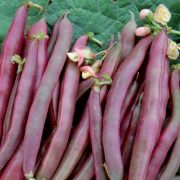
To do so, place all of the pods inside the case, twist it closed, then repeatedly hit it against a hard surface, like the floor, a wall, or a fence. Doing so will dislodge the beans from their pods, allowing you to separate the two, saving the beans for replanting and composting the pod debris.Īnother method for cleaning your beans is by laying them out on a tarp or sheet in a single layer. To separate the beans from the pods, walk all over them (really!), allowing them to crunch underfoot, which will crush the pods but not the beans. If all else fails (or you just prefer to keep your hands busy), you can always process by hand by simply opening the pods and removing the beans. Red beans are grown much like green beans when it comes to watering and fertilizing practices. Bean Runner White Swan Excellent flavour and top quality pods make this white-flowered variety perfect for the garden or allotment. Like the green bean, yard-long beans are the immature pods of these vines, growing rapidly in warm climates such as Southeast Asia. This may be the easiest method if you don't have a large harvest to clean and don't want to break out a bunch of accessories to do so. They need at least an inch of rain per week during their growing season, typically seven months-long if planted in spring. Remember to water the plants every morning if there is no rain. If you want to fertilize your red beans, use a low nitrogen. Pods are an average 28-30cm long and are produced on vigorous plants which are resistant to common bean mosaic virus. The pods can grown many inches in one day the average length is anywhere between one and one and a half feet long. You may be interested to check the Growing Lettuce Hydroponically. Green beans farming is a profitable business.

When you apply fertilizers to bean plants, make sure nitrogen content is approximately half when compared to phosphorus and potassium.Bean plants require regular watering, especially during flowering and pod formation.Mulching is preferred to retain soil moisture and control weeds and soil erosion.Avoid too much nitrogen which can cause lush green foliage.
Red swan beans full#

Rust: This disease can be controlled by dusting with Sulphur 25 kg/ha.Mosaic: To control this remove the affected plants and spray with systemic insecticides to control insect vectors.Powdery mildew: Powdery mildew can be controlled spraying Wettable sulphur at 2 g/lit or dust with Sulphur 25 kg/ha.

Main diseases in beans farming are :1) Powdery mildew 2) Mosaic 3) Rust 4) Anthracnose. Leaf hopper can be controlled by spraying Methyl demeton 25 EC or Dimethoate 30 EC at 2 ml/lit.Pod borer can be controlled by spraying Carbaryl 50 WP 2 g/lit.


 0 kommentar(er)
0 kommentar(er)
